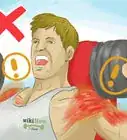This article was co-authored by Dean Theriot. Dean Theriot is a Personal Trainer and the Owner of Timberline Fitness in Houston, Texas. With over 25 years of experience in the fitness industry, Dean specializes in personal, group, and sport-specific training. Dean holds a BS in Exercise Physiology from LSU. Dean combines resistance and cardiovascular training with pilates exercises for comprehensive workouts for his clients. His sport-specific training includes football, basketball, and baseball.
This article has been viewed 75,210 times.
Lateral raises are simple yet effective exercises that can tone your shoulder muscles and improve your physical strength. Requiring only your hands and dumbbells or resistance bands, lateral raises can be done virtually anywhere and at any time of day. Done properly and often enough, performing lateral raises builds muscle on the shoulder cap. This improves your overall physical appearance, making the shoulders broader and more square versus rounded, which can also make the waist appear smaller. Getting the most out of your lateral raise exercises will undoubtedly involve a combination of practice, discipline, and employing a proper technique.
Steps
Preparing for the Workout
-
1Choose your weights. Select a few different dumbbell sizes to experiment with lifting. Make sure you can lift the dumbbell comfortably and repeatedly. Your focus for lateral raises will be building muscle tone, not on lifting heavy weights.
- While dumbbells are most popularly used for this exercise, they are not a requirement for doing lateral raises. You can use a resistance band if you’d prefer not to use dumbbells.
- The main difference between using a resistance band versus free weights is that with a resistance band, you will use your feet to keep the band in place as you pull up on the ends of the band. Your form and technique should be the same as it is with free weights.[1]
- Selecting the correct weight is important and key for lateral raises, but do not get caught up with finding the perfect weight. Using a lighter weight will cause tension and resistance with the more reps you do each set.
-
2Stand or sit with a dumbbell in each hand. Keep your legs shoulder-width apart, hip-width apart or in a split-stance position to keep your body stable.Advertisement
-
3Straighten your back and keep your chest out and open. The arm can be straight (but not locked) during this exercise. If you are using dumbbells, you can also bend your elbow at a 90° angle (do not bend the elbow to 90° if you are using a resistance band).
-
4Keep your chest up, with a slight bend in your elbows. Pull your shoulder blades down and back. You should feel a slight tension in your shoulders, which is completely normal.
Beginning the Raise
-
1Hold a dumbbell in both hands and at your sides. Turn the palms of your hands inward so that they are facing your body. Keep your thumbs wrapped around the dumbbell handles, or turned toward the ceiling if you want to work out different muscle groups.
- Get your torso ready for the raises by tightening your abs and core muscles.
- If you are using a resistance band, stand on the center of the band and take a handle or end of the band in each hand. There should be some tension in the band.[2]
-
2Raise the dumbbells out to the sides, just below shoulder-height. Slowly lift each dumbbell out to the sides, like wings, until your arms are almost parallel to the ground, almost at shoulder-height.[3] Slowly exhale as you use the muscles in the top of your shoulder to lift the dumbbells.[4]
- Keep your head straight and aligned with your spine.
- It the lats are engaged, and the shoulder blades are retracted (as they are supposed to be), it is impossible to lift the arms above shoulder height. If the arms go above shoulder height, the lats are not engaged. If you are doing the exercise correctly, your arms will not go higher than the shoulders.
- If you are using a resistance band, lift the ends of the band as you raise your arms to shoulder-height or just slightly below.[5]
-
3Hold the raise for two to three seconds with a slight bend in your elbow. Allow yourself to build a little tension in your shoulder, making the workout more effective. Keep your core engaged and stabilized.
- Do not flex your wrists or position your arm so that your wrists are higher than your elbows (they should be roughly at the same height or in line). If your wrists are held too high you will shift the work away from your shoulders.[6]
- To prevent this, imagine the dumbbell is actually a bottle of water and you are tilting it forward to pour out the water.
Completing the Rep
-
1Lower your arms slowly back to the start position. Take two to three seconds to slowly lower the dumbbells back down to your start position, steadily inhaling as you go. Your movement should be slow and controlled.
- If you are using a resistance band, slowly lower your hands back to the starting position. Do not allow the tension in the band to pull your arm back for you — this should be a controlled movement.[7]
-
2Keep your arms away from your body. Elevating the arms from the sides of your body will keep the stress on your deltoids.
- Don’t allow your arms to touch your body when you reach the bottom of the movement.
-
3Repeat the move by raising your elbows up and out to the sides. Lead with your elbows so that they’re the highest part of your arm when you do the raise. Your elbows should lead the lift to keep the workout concentrated on your deltoids.[8]
- Concentrate on how your muscles relax and contract when you do the raise.
-
4Complete 10 – 12 reps per set. Keep the reps slow and consistent to build resistance in your arms. Repeat until you’ve completed a minimum of three sets.
- Aim to complete three sets three days a week, for at least six weeks to start seeing results.
- Increase or decrease the number of reps you do per set to change your level of difficulty.
Expert Q&A
Did you know you can get expert answers for this article?
Unlock expert answers by supporting wikiHow
-
QuestionHow do you do a bent over lateral raise?
 Michele DolanMichele Dolan is a BCRPA certified Personal Trainer in British Columbia. She has been a personal trainer and fitness instructor since 2002.
Michele DolanMichele Dolan is a BCRPA certified Personal Trainer in British Columbia. She has been a personal trainer and fitness instructor since 2002.
Certified Fitness Trainer
-
QuestionAre lateral raises a push or pull?
 Michele DolanMichele Dolan is a BCRPA certified Personal Trainer in British Columbia. She has been a personal trainer and fitness instructor since 2002.
Michele DolanMichele Dolan is a BCRPA certified Personal Trainer in British Columbia. She has been a personal trainer and fitness instructor since 2002.
Certified Fitness Trainer
-
QuestionWhat do lateral raises work out?
 Michele DolanMichele Dolan is a BCRPA certified Personal Trainer in British Columbia. She has been a personal trainer and fitness instructor since 2002.
Michele DolanMichele Dolan is a BCRPA certified Personal Trainer in British Columbia. She has been a personal trainer and fitness instructor since 2002.
Certified Fitness Trainer
Warnings
- Don’t allow the dumbbells to touch your body or “hang down” at the bottom of any movement.⧼thumbs_response⧽
- Don’t lift your arms any higher than parallel if you've previously injured your rotator cuff.⧼thumbs_response⧽
- Potential injuries to the lower back may be incurred if this exercise is performed incorrectly.⧼thumbs_response⧽
Things You Need
- Dumbbells (optional)
- Resistance band (optional)
- Towel (optional)
References
- ↑ https://www.t-nation.com/training/tip-use-bands-for-lateral-raises
- ↑ http://www.bodybuilding.com/exercises/detail/view/name/lateral-raise-with-bands
- ↑ Dean Theriot. Personal Trainer. Expert Interview. 22 February 2021.
- ↑ http://www.muscleandfitness.com/workouts/shoulder-exercises/videos/dumbbell-lateral-raise
- ↑ http://www.bodybuilding.com/exercises/detail/view/name/lateral-raise-with-bands
- ↑ https://www.muscleandstrength.com/exercises/dumbbell-lateral-raise.html
- ↑ http://www.bodybuilding.com/exercises/detail/view/name/lateral-raise-with-bands
- ↑ http://www.webmd.com/pain-management/picture-of-the-rotator-cuff
About This Article
Lateral raises can tone your shoulder muscles and improve your overall strength. All you need to do this exercise is a set of dumbbells or resistance bands. First, position your arms by your sides and hold a dumbbell in each hand. Then, slowly raise your arms until the dumbbells are just below shoulder height. Keep your elbows slightly bent and hold the raise for 2 to 3 seconds. To complete the rep, slowly lower your arms back down to your sides. Repeat the movement 10 to 12 times per set. For more advice from our Personal Trainer co-author, like how to choose the right weights, read on!



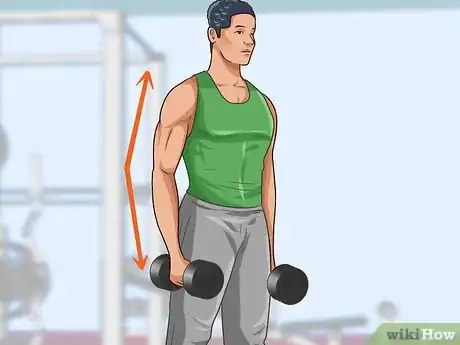
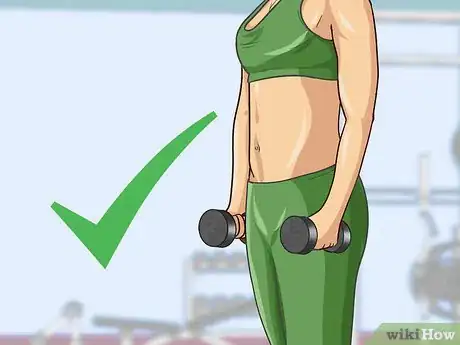

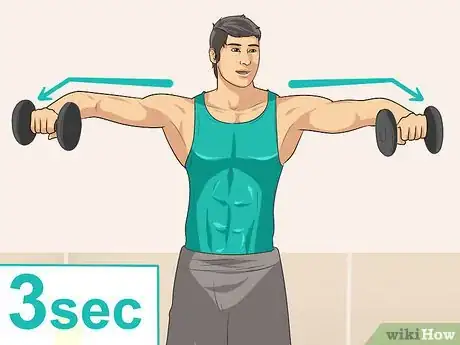
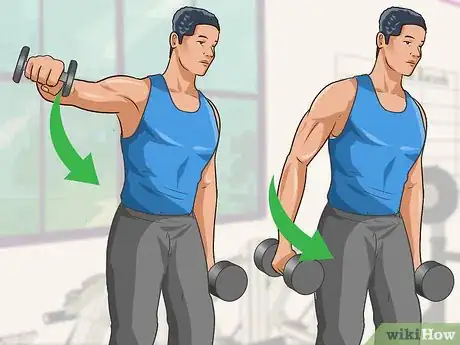
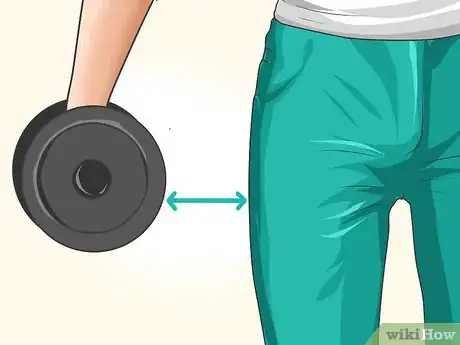
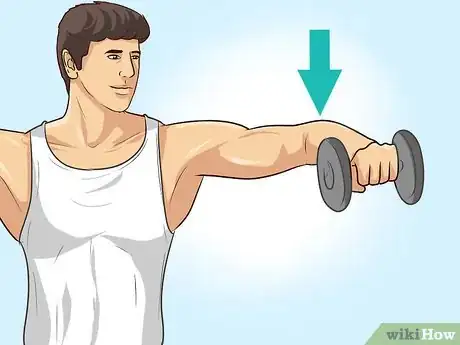
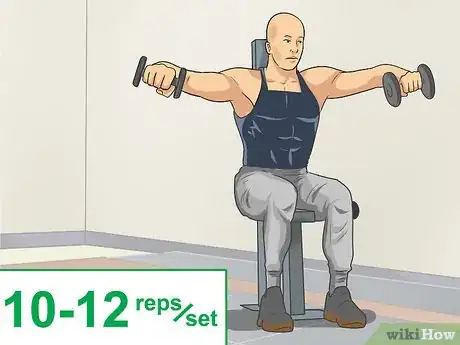




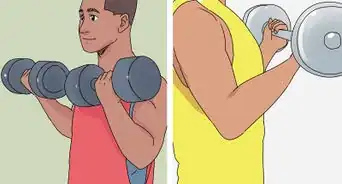


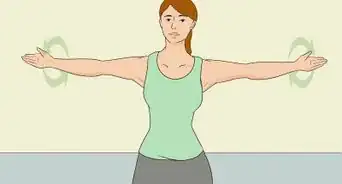
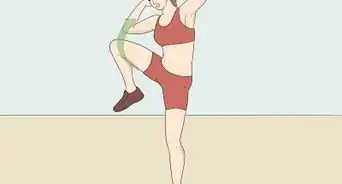
-Step-10-Version-5.webp)






